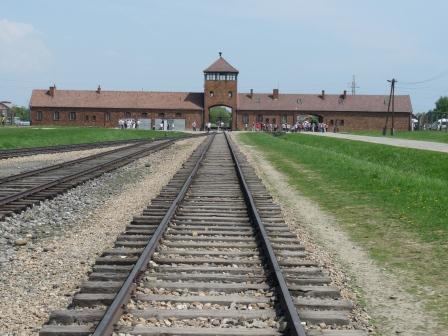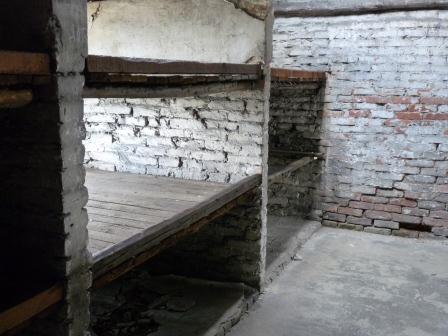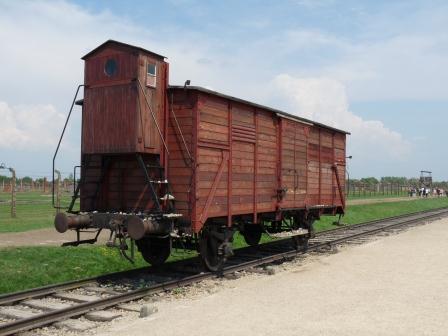This is the 2nd of 3 related postings regarding Auschwitz. The first post is available here.
As many as 1 million Jews had already been murdered by the Nazis when they made the decision, in January 1942, to systematically kill all the Jews of Europe. This was described by Hitler as the “Final solution to the Jewish Question”. The initial extermination method of shooting people in burial pits was logistically inefficient and psychologically difficult, so in late 1941, the Nazis began establishing camps specifically intended for mass murder using gas chambers. These camps had as their primary function genocide, the systematic killing of the people delivered there, although some also functioned as forced labour camps.
Extermination camps were built where most of the intended victims lived and Poland had the greatest concentration of Jews in Europe. In the early years of the Holocaust, Jews were often sent to concentration camps with other prisoners, but from 1942 onward they were primarily sent to extermination camps. The 6 main extermination camps, all located in Poland, were: Auschwitz II–Birkenau, Chelmno, Bełżec, Majdanek, Sobibor, and Treblinka.
Construction of Auschwitz II-Birkenau began in October 1941 to ease congestion at Auschwitz I. It was designed as a labour camp to hold several categories of prisoners including women, and also to function as an extermination camp. It was larger than Auschwitz I and many more people passed through its gates.

Despite the terrible living conditions in Auschwitz I, it was far superior to Auschwitz II-Birkenau. At Auschwitz I the barracks were made of brick but at Birkenau, most of the barracks were pre-fabricated wooden buildings designed to be used as horse stables. As a result of their flimsy construction they have since disintegrated, but some have been re-built to allow visitors to see what they did look like. The barracks were for the most part unheated and lacked any insulation, so they were freezing cold in winter. In the summer they were hot and humid, with the terrible smell of having so many sick people crowded together. People slept 5 or more to a bed on 3 levels. Those on the lowest level slept on the concrete floor.

Women had a particularly bad life in Birkenau. They suffered greatly from being separated from their children and family. Additionally, they didn’t have many of the skills that the men did to maintain their barracks, so their living conditions were even more wretched.
Initially small gas chambers were located in the woods at Birkenau to avoid detection. They were created by sealing up existing buildings. The bodies were buried in pits but had to be exhumed and cremated later when the ground started to collapse. In 1943 four large gas chambers and crematoria were constructed at Birkenau to make the killing more efficient. The majority of the victims of Auschwitz were murdered after this time. The facility had the capacity to kill up to 20,000 people each day.

Prisoners arrived by train crammed into unheated cattle cars. Many died during transport. By July 1942, the SS were conducting ‘selections’ where doctors divided Jews into those deemed fit for work, who were sent to the right and admitted into the camp, and those who were sent to the left to be immediately gassed. The group selected to die, about three-quarters of the total, included almost all children, women with children, all the elderly, and all those who appeared on brief and superficial inspection not to be completely fit.
There was no registration of those who were selected for death. Men, women, and children were immediately marched a couple of hundred meters along the railway tracks, right past the camp ‘hospital’. They were stripped of all their belongings and their clothes, and herded in to the gas chambers. Diane and I walked the same route as those selected to die.
People who were sent to the camps didn’t know what to expect. They were told that they were being re-located there. They brought what luggage they could to prepare for their stay. In some cases, they were even excited about the prospect of meeting a friend or relative who had been sent there previously. For nefarious reasons, this ruse was maintained right up until the last moments. New arrivals were told they were going to be given showers and deloused. The gas chambers were equipped with fake shower heads to mislead them so they would stay calm as they entered. The guards delivered speeches about what they should do after their shower was completed. They were also reassured by the fact that they saw many barrack buildings in the camp, evidence of the fact that other prisoners were living there.
“Technically [it] wasn’t so hard—it would not have been hard to exterminate even greater numbers…. The killing itself took the least time. You could dispose of 2,000 head in half an hour, but it was the burning that took all the time. The killing was easy; you didn’t even need guards to drive them into the chambers; they just went in expecting to take showers and, instead of water, we turned on poison gas. The whole thing went very quickly.” – Rudolf Höss
What did the inmates of the camp feel as they saw the trains arriving daily, watched the Jews being marched down the tracks never to return, and smelled the burning bodies. How could they persevere?
The extermination facilities were staffed partly by prisoners called sonderkommandos. They prepared new arrivals for gassing (ordering them to remove their clothing and surrender their personal possessions) and transferred corpses from the gas chambers to the crematoria, having first pulled out any gold that the victims might have had in their teeth. Commandant Höss reported being impressed by the diligence of the Sonderkommandos, despite their being “well aware that . . . they, too, would meet exactly the same fate” because members of the sonderkommandos were also killed periodically. Höss further reported that the men occasionally encountered the corpse of a relative, but, although they “were obviously affected by this . . . it never led to any incident”. He mentioned the case of a Sonderkommando who encountered the corpse of his wife, yet behaved “as though nothing had happened”. What fear and torment must these men have endured to suppress all emotion in order to conduct these tasks?
In 1943 and 1944 the Allies received reports from prisoners who had escaped Auschwitz, which at first were dismissed as exaggerations. Although the reports were detailed, it was hard for anyone to believe that industrialized killing on such a mass scale was taking place.
The gas chambers worked to their fullest capacity from April to July 1944 during the massacre of Hungary’s Jews. Hungary was an ally of Germany for most of World War II, but it had resisted turning over its Jews to the Germans, until Germany invaded Hungary in March 1944. From April until July 1944, 475,000 Hungarian Jews, half of Hungary’s pre-war population, were deported to Auschwitz, a rate of 6,000 – 12,000 a day. The incoming volume was so great that the SS resorted to burning corpses in open-air pits as well as in the crematoria. Burning in pits took as long as 24 hours.

It is estimated that 1.3 Million people died at Auschwitz between 1940 and 1945 including 1.1 Million Jews, 150,000 Poles, 23,000 Roma (‘gypsies’), 15,000 Soviet POWs, 34,000 prisoners transferred from other camps, and 25,000 other people. The ashes of the victims of Birkenau were scattered on the grounds and between the barracks, so the entire area is considered a burial site, the largest in the world. The ground upon which thousands of visitors walk is composed of the remains of the victims.
To be continued. This is the 2nd of 3 related postings about Auschwitz. The first post is available here. The last post will focus on my experience visiting the memorial.
Brilliant Read… I have to read your first post now.. It’s so sad, the way they were treated:(